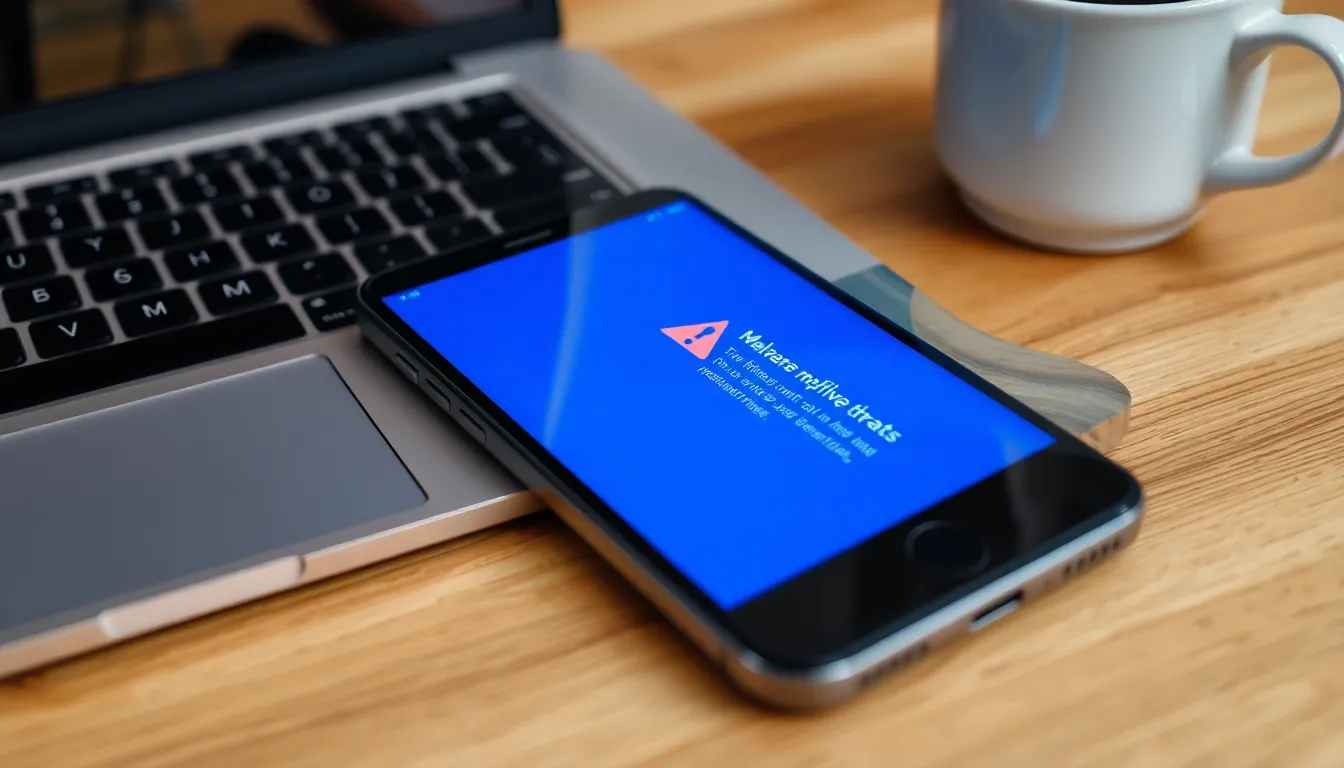Table of Contents
ToggleIn today’s fast-paced digital world, mobile devices have become essential tools for communication, banking, and entertainment. With this increased reliance on smartphones and tablets, the need for robust mobile security has never been more critical. Cyber threats are evolving, targeting vulnerabilities in apps and operating systems, leaving users at risk of data breaches and identity theft.
Understanding mobile security is vital for anyone who uses a smartphone. It’s not just about installing antivirus software; it involves adopting best practices to protect sensitive information. From secure passwords to encrypted communications, every user can take steps to safeguard their devices. As mobile technology continues to advance, staying informed about security measures is key to enjoying the convenience of mobile life without compromising safety.
Overview of Mobile Security
Mobile security encompasses measures and technologies designed to protect mobile devices, applications, and networks from threats. Key concerns include malware, data breaches, and unauthorized access, all of which can lead to significant loss and compromise sensitive information.
Increasing reliance on mobile devices for personal and financial transactions elevates the risks. Cybercriminals exploit vulnerabilities in mobile operating systems, applications, and even network connections. Effective mobile security involves multiple layers, including secure app development, regular system updates, and user awareness.
Best practices enhance mobile security. Users should enable strong passwords, utilize two-factor authentication, and regularly review app permissions. Additionally, employing encryption for sensitive communications adds another layer of protection.
Continuous education about emerging threats and security technologies is crucial for users. Awareness built through resources and tools empowers users to adopt proactive measures, strengthening overall mobile security.
Common Threats to Mobile Security

Mobile devices face various security threats that compromise user data and privacy. Recognizing these threats is essential for safeguarding sensitive information.
Malware and Viruses
Malware encompasses malicious software designed to infiltrate mobile devices, causing significant harm. Types of malware include trojans, spyware, and ransomware. Trojans disguise themselves as legitimate applications, tricking users into installation. Spyware monitors user activity, collecting sensitive information without consent. Ransomware locks users out of their devices or data until a ransom is paid.
Mobile malware often spreads through infected apps downloaded from untrusted sources or malicious links. Users should prioritize downloading apps exclusively from official app stores and keep their devices updated to minimize vulnerabilities. Regularly scanning for malware can detect and eliminate threats effectively.
Phishing Attacks
Phishing attacks aim to deceive users into revealing personal information, such as passwords and credit card numbers. Cybercriminals often use generic messages that mimic legitimate companies, creating a sense of urgency, making users more likely to comply.
Phishing attempts frequently occur via email, SMS, or social media messages. Users should remain vigilant, verifying the source of communications before clicking on links or sharing information. Employing features like spam filters and two-factor authentication can significantly reduce the risk of falling victim to phishing attacks.
Best Practices for Enhancing Mobile Security
Enhancing mobile security requires adherence to several critical best practices. These actions significantly reduce vulnerabilities and protect personal information.
Regular Software Updates
Regular software updates ensure that devices operate on the latest security patches. Each update from operating systems or applications often contains fixes for identified vulnerabilities, making it essential to install them promptly. Users should enable automatic updates whenever possible to maintain up-to-date software. According to the Cybersecurity & Infrastructure Security Agency (CISA), keeping software current prevents exploitation by cybercriminals targeting outdated systems.
Utilizing Strong Passwords
Utilizing strong passwords forms the first line of defense against unauthorized access. Passwords should consist of at least 12 characters, including a mix of upper and lower case letters, numbers, and special symbols. Users should avoid common words and personal information that could be easily guessed. Password managers can securely store and generate complex passwords, enhancing both security and convenience. Additionally, changing passwords regularly limits the risk if a password gets compromised, reinforcing overall mobile security.
Mobile Security Tools and Apps
Mobile security tools and apps play a vital role in safeguarding devices from emerging threats. Utilizing the right tools enhances the protection of sensitive data stored on smartphones and tablets.
Antivirus Software
Antivirus software protects mobile devices by detecting and eliminating malware, trojans, and spyware. These programs continuously scan for malicious applications, providing users with real-time alerts. Top antivirus options, such as Norton Mobile Security and McAfee Mobile Security, offer features like app privacy reports and safe browsing tools. Regular updates from these services ensure users have the latest protection against evolving threats. Users should install antivirus software not just for malware detection but also for features that enhance overall device security.
VPN Services
VPN services encrypt internet connections, shielding users’ online activities from potential snoopers and hackers. By masking IP addresses, Virtual Private Networks help maintain anonymity while browsing. Reputable VPN providers like ExpressVPN and NordVPN not only protect data on public Wi-Fi but also bypass geographic restrictions on content. Users benefit from enhanced privacy and security, especially when accessing sensitive information on unsecured networks. Selecting a VPN with a no-log policy further strengthens data protection against cyber threats.
Future Trends in Mobile Security
Emerging trends in mobile security reflect the evolving threat landscape and technological advancements. These trends will shape how users and organizations address vulnerabilities in mobile devices.
- Artificial Intelligence (AI) and Machine Learning (ML)
AI and ML technologies enhance threat detection and response capabilities. Security solutions increasingly utilize these technologies to analyze user behavior and identify anomalies, allowing for real-time threat identification.
- Zero Trust Security Models
The zero trust approach reinforces the need to verify users and devices continuously. This model minimizes reliance on perimeter security and ensures that every access request undergoes strict authentication, regardless of the network location.
- Biometric Authentication
Biometric authentication, including facial recognition and fingerprint scanning, is gaining popularity. These methods offer more secure alternatives to traditional passwords, making unauthorized access more difficult.
- 5G Technology
The rollout of 5G technology introduces higher speeds and increased connectivity but also presents new security challenges. Developers must prioritize the safeguards necessary to protect data transmitted over these faster networks.
- Increased Focus on Privacy Regulations
Stricter privacy regulations, such as the GDPR and CCPA, influence mobile security practices. Companies are adopting measures to comply with these regulations, focusing on data protection and user consent.
- Enhanced App Security
Developers will focus on building more secure applications through secure coding practices and regular vulnerability assessments. App stores will also enforce stricter security protocols for applications available to users.
- IoT Integration
The proliferation of Internet of Things (IoT) devices necessitates improved security measures for interconnected mobile devices. Users and businesses must implement robust security protocols to safeguard against IoT-related threats.
- Cybersecurity Awareness Training
Organizations are prioritizing user education to combat social engineering attacks. Continued training helps employees recognize phishing attempts and ensure they follow best practices for mobile security.
These trends highlight the importance of proactive measures in safeguarding mobile devices against evolving threats. As technology continues to advance, staying informed about the latest developments will be crucial for mobile security.
Mobile security is no longer optional; it’s essential in today’s digital landscape. As users increasingly rely on their devices for sensitive tasks, the risks associated with cyber threats continue to grow. Adopting comprehensive security measures and best practices is vital for protecting personal data and maintaining privacy.
Staying informed about emerging threats and leveraging security tools can significantly enhance device protection. With advancements like AI and biometric authentication on the horizon, users must remain vigilant and proactive in their approach to mobile security. Ultimately, a commitment to understanding and implementing effective security strategies will empower individuals to navigate the mobile world safely and confidently.







